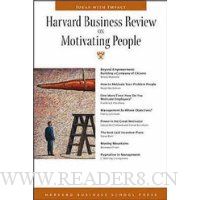基本信息·出版社:Harvard Business School Press ·页码:212 页 ·出版日期:2003年05月 ·ISBN:1591391326 ·条形码:9781591391326 ·版本:2003-0 ...
| 商家名称 |
信用等级 |
购买信息 |
订购本书 |
|
|
 |
Harvard Business Review on Motivating People |
 |
|
 |
Harvard Business Review on Motivating People |
 |

基本信息·出版社:Harvard Business School Press
·页码:212 页
·出版日期:2003年05月
·ISBN:1591391326
·条形码:9781591391326
·版本:2003-05-01
·装帧:平装
·开本:32开 Pages Per Sheet
·丛书名:Harvard Business Review Paperback Series
·外文书名:哈佛商业评论: 激发员工
内容简介 Book DescriptionHarvard Business Review on Motivating PeopleLack of motivation can lead to employee inefficiency and low productivity-not to mention higher turnover rate. This evergreen collection of Harvard Business Review articles will help managers in struggling companies retain their key workers and create happy working environments. This timeless volume features new and classic articles on leadership, inspiration, compensation, performance measurement, and more.
The Harvard Business Review Paperback SeriesThe series is designed to bring today's managers and professionals the fundamental information they need to stay competitive in a fast-moving world. From the preeminent thinkers whose work has defined an entire field to the rising stars who will redefine the way we think about business, here are the leading minds and landmark ideas that have established the Harvard Business Review as required reading for ambitious businesspeople in organizations around the globe.
About HBRHarvard Business Review is a general management magazine published since 1922 by Harvard Business School Publishing, owned by the Harvard Business School. A monthly research-based magazine written for business practitioners, it claims a high ranking business readership and enjoys the reverence of academics, executives, and management consultants. It has been the frequent publishing home for well known scholars and management thinkers, among them Clayton M. Christensen, Peter F. Drucker, Michael E. Porter, Rosabeth Moss Kanter, Gary Hamel, C.K. Prahalad, Robert S. Kaplan, and others. Management and business concepts and terms such as "Balanced scorecard," "Core competence," "Strategic intent," "Reengineering," "Globalization," "Marketing myopia," and "Glass ceiling" were first given prominence in HBR's pages. Its worldwide English-language circulation is 240,000, and there are 11 licensed editions of the magazine, including two Chinese-language editions, a German edition, and an English-language South Asia edition. The magazine is editorially independent of Harvard Business School. It is not peer reviewed.
Book Dimension length: (cm)20.8 width:(cm)13.9
专业书评 Occupying the broad middle ground between cutthroat competition and outright merger, a strategic alliance can be almost any collaborative arrangement by which companies share capital, technology, distribution networks, manufacturing facilities or a host of other resources. It's a vast and somewhat amorphous topic, but this wide-ranging collection of papers from the Harvard Business Review gives a coherent and useful introduction. The writers, academics and business executives, provide both conceptual clarity and practical insight into a variety of collaborative arrangements. Gary Hamel, Yves L. Doz and C.K. Prahalad explore the tension inherent in strategic alliances, with partners who are often competitors in the same industry trying to learn each other's secrets without revealing too many of their own. Ashish Nanda and Peter J.Williamson show how joint ventures can refurbish a troubled business unit and prepare it for a lucrative sale. Carlos Ghosn recounts the turnaround of ailing car maker Nissan thanks to a partnership with Renault. Henry W. Chesbrough and David J. Teece use IBM's introduction of the PC as a case study in the promise and pitfalls of the "virtual corporation" that outsources virtually everything to collaborators. A few papers, like Rosabeth Moss Kanter's facile comparison of strategic alliances to romantic alliances, are unhelpful. But for the most part, these readable essays manage to combine rigorous theory with down-to-earth detail. Business executives trying to get a handle on this bewildering subject will find this book a good place to start.
Copyright 2003 Reed Business Information, Inc.
目录 1.Beyond Empowerment: Building a Company of Citizens by Brook Manville and Josiah Ober
2.How to Motivate Your Problem People by Nigel Nicholson
3.One More Time: How Do You Motivate Employees? by Frederick Herzberg
4.Management by Whose Objectives? by Harry Levinson
5.Power Is the Great Motivator by David C. McClelland and David H. Burnham
6.The Best-Laid Incentive Plans by Steve Kerr
……




